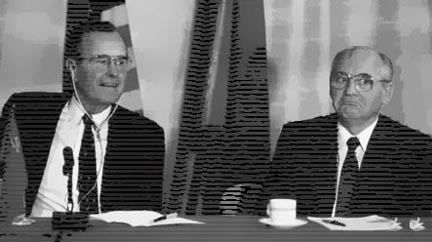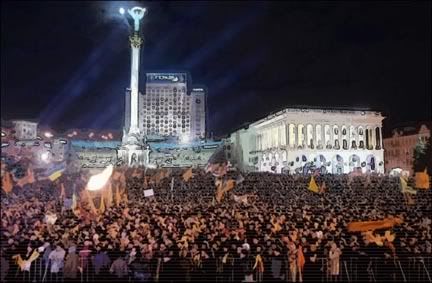Caustic logic/Guerillas Without Guns
Posted March 7 2007
updated and edited a bit, 11/11/09
The USSR’s demise came not a minute too soon for Washington’s grandest ambitions of world power. Near the end of his tenure, Soviet premier Mikhail Gorbachev was setting himself up to assume a major continued role in the world. His domestic legacy of Glasnost (openness) and Perestroika (economic restructuring) had greatly softened the Soviet image in a world that he noted was growing more interconnected and self-aware. He apparently fancied himself a bit of a latter-day Woodrow Wilson, and publicly laid his utopian plans for an end to the Cold War and its replacement with something called a “new world order,” to be led by the USSR and the US working in harmonious tandem. He first announced this on December 7 1988 at a UN assembly: “further world progress is now possible only through the search for a consensus of all mankind, in movement toward a new world order.” [1]
He wasn’t the first to use the phrase; it’s been a perennial favorite of idealist rhetoric since at least World War I and is even on our US currency. But his specific formulation was unprecedented in that it came from a Soviet leader and that it was taken serious by many worldwide, premised deftly on the concerns of the day. He offered a partial Soviet surrender as it were, an end to economic blocs and creation of one global capitalist economy if with local variations. He foresaw beyond this a gentler world of great power cooperation, wider democracy and social justice, environmental protection, nonviolent conflict resolution and of course nuclear disarmament. Gorbachev’s proposal was seen by many as a rambling pipe dream, but his idealism boosted Soviet influence in Europe, and in 1990 he was awarded the Nobel Peace Prize.
Of course there were motives other than pure high-minded Pollyannaism at work; with a mismanaged economy in decline and a military drained by the eight-year war in Afghanistan, Gorbachev’s plan seems to have been to replenish Soviet power with his bold injection of intellectual capital. When you’re short on both guns and butter, a good enough idea may help fill the gap. The premier explained that despite the disagreements that had held the past in a chokehold, mutual respect was the to be the new paradigm. “For a new type of progress throughout the world to become a reality, everyone must change,” he stressed in June 1990. “Tolerance is the alpha and omega of a new world order.” [2]
 |
As the tougher-minded in Washington saw it, partnership with Moscow was less necessary by the end of 1989; the writing was on the wall and the hawks were preparing for a different new world order - one without the Soviet Union. Gorbachev’s soft attitude and the general Soviet weakness freed their hand to pursue hot war over their own interest with less reservation than in the past. The initial test of this freedom of movement was the US conflict with Panama of December 1989, just weeks after Malta. With charges of drug dealing by president Noriega as justification, this easily-won, small-scale neighborhood war began the “reluctant sheriff” phase of America’s self-appointed post-Cold War military role.
But that “reluctant sheriff” called his next high-noon showdown within less than a year. Iraqi President Saddam Hussein had just escaped a draining eight-year war with Iran, and in August 1990 responded to a string of apparently American-sponsored provocations by ordering a full invasion and annexation of his tiny, oil-rich neighbor Kuwait. The Americans had first told him they had “no opinion” on such “Arab-Arab disputes” as the border disagreement with Kuwait, but once carried out, this brazen act was taken as the first real challenge to the nascent and ill–defined new world order. [4] At this point Bush finally took the linguistic offensive, tapping into Gorbachev’s vein of optimistic ideals in a speech on September 11 1990:
“Out of these troubled times, our fifth objective - a new world order - can emerge: a new era - freer from the threat of terror, stronger in the pursuit of justice, and more secure in the quest for peace. […] Today that new world is struggling to be born, a world quite different from the one we've known. […] [Gorbachev] and other leaders from Europe, the Gulf, and around the world understand that how we manage this crisis today could shape the future for generations to come.”
Bush stressed in his speech “this is the first assault on the new world that we seek, the first test of our mettle.” America rose to the occasion with its ready and eager military and an increasing momentum of international resolve. Gorbachev was reportedly torn between his desire for purely peaceful ends and the obvious (linguistic) similarity of Washington’s approach to his own vision of cooperation. [5] Working with Secretary of State James Baker, Bush pulled every trick in the book, not least flattery, to swing Soviet opinion behind the war plan in hopes of unanimity in the UN Security Council.
Permanent member China was persuaded to abstain, voting neither way, Yemen and Cuba (then two of the ten rotating members) were the only no votes (repaid with more sanctions) and the USSR followed Washington’s lead, joining 11 other yes votes on Security Council Resolution no. 678 in November 1990. Saddam was thus given a deadline of January 15 to withdraw or face UN forces, and so Bush, Baker, Shevardnadze, et al. had forged the first Security Council-approved military action since the fluke of approval for the Korean conflict at the UN’s dawn in 1950. This sudden usefulness of the UN was new, it was all about world order, and would go down as Bush’s legacy, not Gorbachev’s.
All it took was some serious follow-through, and the forces were already built up in neighboring Saudi Arabia – ostensibly neither to attack Iraq nor to liberate Kuwait, but only to defend the Saudi Kingdom from what the Americans insisted was a realistic threat of an Iraqi invasion. The military machine that assembled itself during late 1990 in sprawling bases in the Saudi desert were primarily American and British, no Soviet troops took part. Bush offered to have Soviet troops in the coalition, as noted by then National Security Adviser Brent Scowcroft, but Gorbachev apparently declined the honor. [6] It was the largest American military buildup since the Vietnam War, and designed to finally wash that war’s bad taste from America’s maw. By the end of the year, over a half-million soldiers and a mind-boggling arsenal of advanced weaponry was announced as offensive capable and ready to enforce Security Council Resolution 678.
For whatever reason, Saddam failed to withdraw by the deadline. Air strikes began a few days after and through late January and all of February pounded targets across Iraq with a bombardment that rivaled anything since World War II. On February 22, Iraq agreed to a Soviet-sponsored cease-fire agreement calling for a withdrawal in three weeks to be overseen by the Security Council. The US rejected the proposal and kept bombing, two days later launching the final phase with coalition ground forces pushing through Kuwait and into Iraq. Saddam finally surrendered and the US shot up some of the (retreating? withdrawing?) columns. But Bush refused to push on to Baghdad. Saddam was left in power though locked in a “box” of sanctions and weapons inspectors, to be policed by the world community.
Immediately after the war was finished, President Bush lauded the cooperative spirit of world community – the US and USSR were on the same side! He declared in a speech on March 6, 1991:
“The Gulf war put this new world to its first test. And my fellow Americans, we passed that test. […] Even the new world order cannot guarantee an era of perpetual peace. But enduring peace must be our mission. Our success in the Gulf will shape […] the new world order we seek.”
In this process, Gorbachev had followed hopefully, but the war had been an American game and by now so was the Cold War. 1990 saw a weaker Moscow granting more autonomy to the constituent republics, and 1991 was mired in deeper crisis yet with Russia’s role in the USSR itself coming into question. Just six months after the end of the Gulf war, a coup by Communist hardliners had the premier sidelined for three days in August amid a nationwide “emergency.” This spurred strong international condemnation and threats, massive strikes and protests from the Russian public, and deft moves by an emerging new class of West-friendly leaders like Boris Yeltsin and Vladimir Putin.
The liberal Gorbachev was thus restored but the final slide had been entered. Half the Republics took the chance provided by the coup’s chaos in Moscow to declare independence, and the USSR’s final dissolution was recognized by all parties in December. As 1992 dawned, the Pro-West Yeltsin was in power in the new Russian Federation, by far the largest of the newly independent constituent republics. Where there had been one massive, monolithic nation there now stood massive Russia (with its south Baltic exclave of Kaliningrad) and fourteen smaller republics.
Some semblance of a regional cooperation framework was maintained with the Commonwealth of Independent States (CIS). The creation of the CIS in December 1991 is what officially marked the end of the USSR. It was agreed to by Russia, Ukraine and Belarus to ensure a “civilized divorce” of the republics, yet it continues on to the present time, eventually including all the former SSRs minus the Baltic states: Latvia, Lithuania, and Estonia, who sought to escape Russia’s sphere as totally as possible.
The Cold War was over and the West officially emerged victorious. It was a heady time in Washington and a bit of a dreamland. Influential American thinker Francis Fukuyama even wrote about the “end of history,” first in a 1989 article and later in a 1992 book The End of History and the Last Man. Fukuyama explained “a remarkable consensus concerning the legitimacy of liberal democracy as a system of government had emerged throughout the world over the past few years, as it conquered rival ideologies like hereditary monarchy, fascism, and most recently communism.” Fukuyama defines history narrowly as the development of political ideologies, and so the emergent liberal democracy constitutes the “end point of mankind’s ideological evolution” and as such marked the termination of the historic process. [7] History is over because we had won, Fukuyama’s case seems to run. We put the period at the end of the sentence because all of history has leading up to the perfection we are. We the liberal Democratic New World Order, we the Last Men of the West.
Next:
Euro-NATO: How the West was Run
Sources:
[1], [2], Wikipedia. “New world order.” last modified 21 July 2006. http://en.wikipedia.org/wiki/New_world_order
[3] George H.W. Bush and Brent Scowcroft. A World Transformed, ISBN 0679752595, pp. 42-43.
[4] Clark, Ramsey. The Fire This Time: US War Crimes in the Gulf. New York. Thunder’s Mouth Press. First edition, First Printing. 1992. Page 12-19.
[5] Aldrich-Moodie, Benjamin. “Negotiating Coalition: Winning Soviet Consent to Resolution 678 Against Iraq”
Woodrow Wilson school of Public and International Affairs. WWS Case Study 1/98
http://www.wws.princeton.edu/cases/papers/negotiating.html
[6] see [3], pp. 361-364.
[7] Fukuyama, Francis. “The End of History and the Last Man. (intro) Penguin. 1992.
http://www.marxists.org/reference/subject/philosophy/works/us/fukuyama.htm


No comments:
Post a Comment